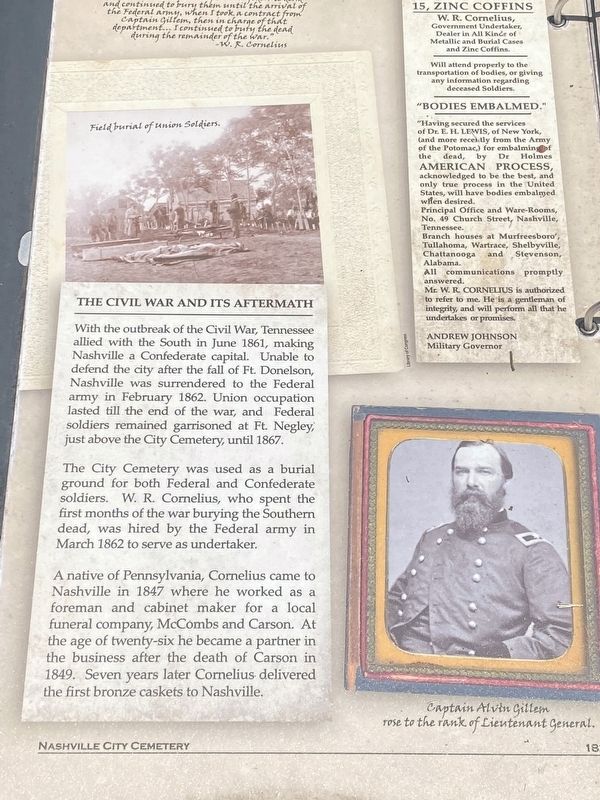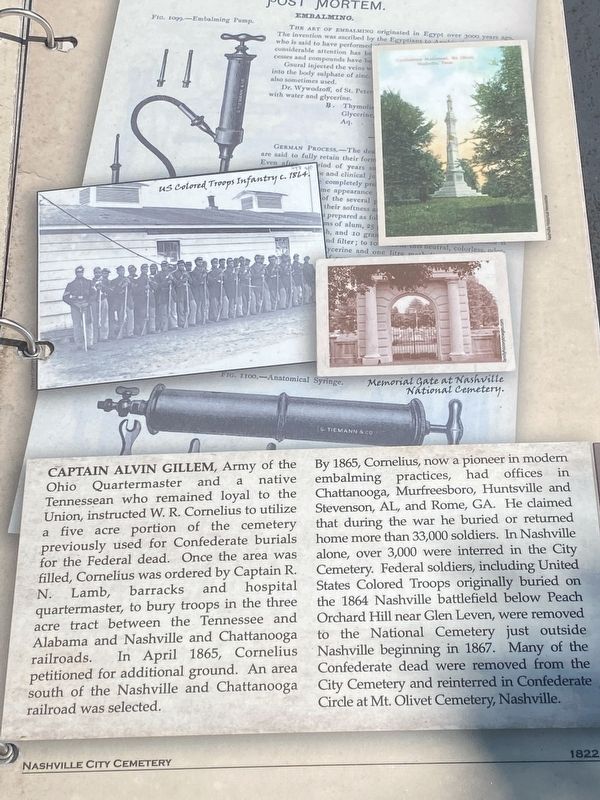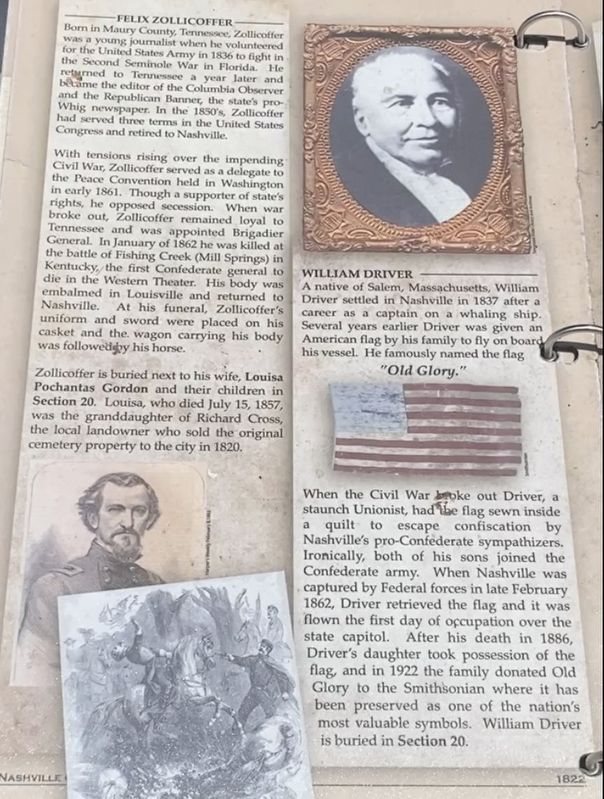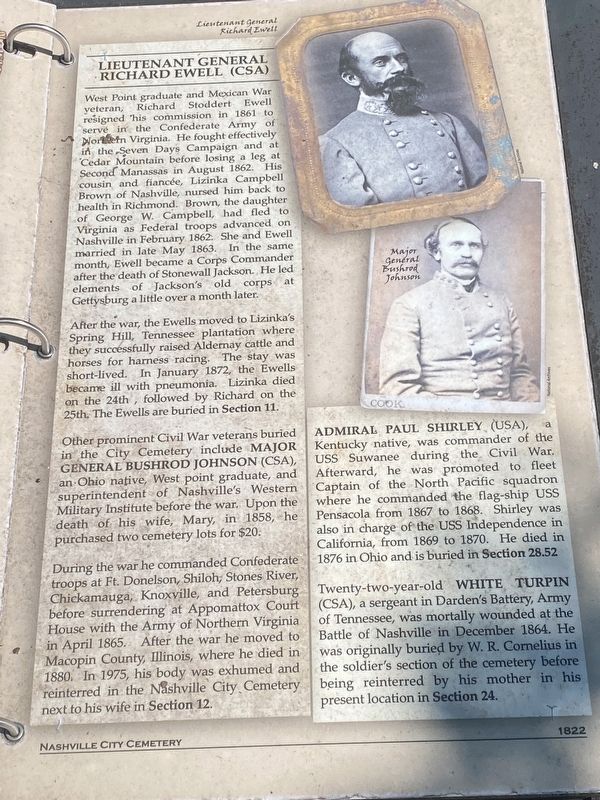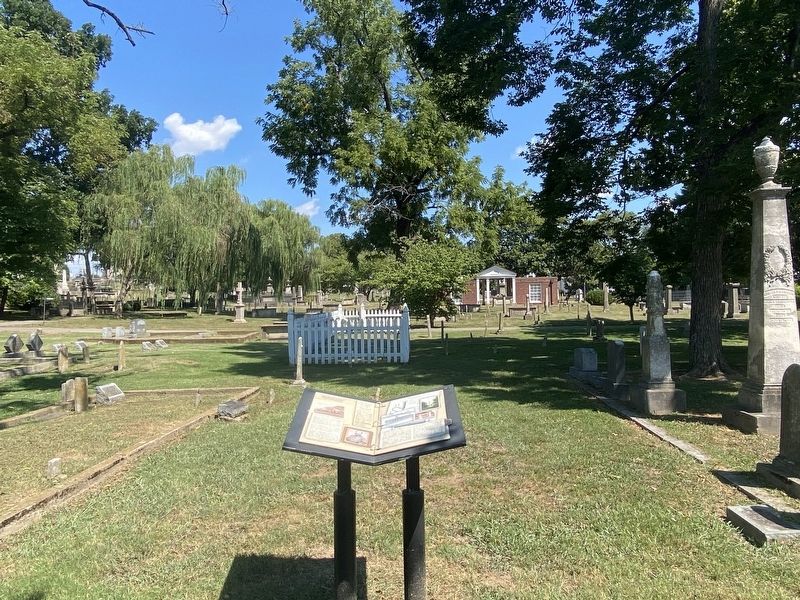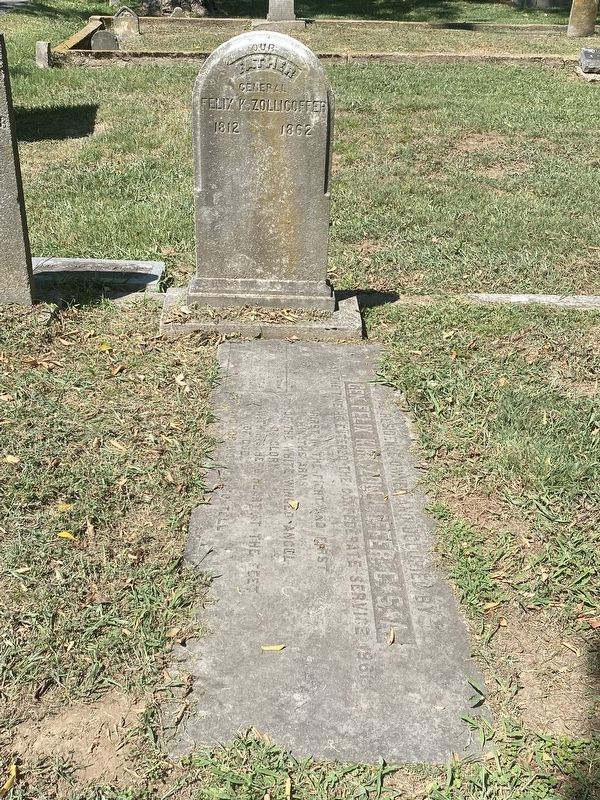South Nashville in Davidson County, Tennessee — The American South (East South Central)
The Civil War and Its Aftermath
The City Cemetery was used as a burial ground for both Federal and Confederate soldiers W.R. Cornelius, who spent the first months of the war burying the Southern dead, was hired by the Federal army in March 1862 to save as undertaker.
A native of Pennsylvania, Cornelius came to Nashville in 1847 were he worked as a foreman and cabinet maker for a local funeral company, McCombs and Carson. At the age of twenty-six he became a partner in the business after the death of Carson in 1849. Seven years later Cornelius delivered the first bronze casket to Nashville.
Captain Alvin Gillem, Army of the Ohio Quartermaster and a native Tennessean who remained loyal to the Union, instructed W.R. Cornelius to utilize a five acre portion of the cemetery previously used for Confederate burials for the federal dead. Once the area was filled, Cornelius was ordered by Captain R. N. Lamb, barracks and hospital quartermaster, to bury troops in the three acre tract between the Tennessee and Alabama and Nashville and Chattanooga railroads. in April 1865, Cornelius petitioned for additional ground. An area south of the Nashville and Chattanooga railroad was selected.
By 1865, Cornelius, now a pioneer in modern embalming practices, had offices in Chattanooga, Murfreesboro, Huntsville, and Stevenson, AL, and Rome, GA. he claimed that during the war, he buried or returned home more than 33,000 soldiers. In Nashville alone, over 3,000 were interred in the City Cemetery. federal soldiers, including United States Colored Troops originally buried on the 1864 Nashville battlefield below Peach Orchard Hill near Glen Leven, were removed to the National Cemetery just outside Nashville beginning in 1867. Many of the Confederate dead were removed from the City Cemetery and reinterred in Confederate Circle at Mt. Olivet Cemetery, Nashville.
Felix Zollicoffer
born in Maury County, Tennessee, Zollicoffer was a young journalist when he volunteered for the United States Army in 1836 to fight in the Second Seminole War in Florida. he returned to Tennessee a year later and became the editor of the Columbia Observer and the Republican Banner, the state's pro-Whig newspaper. In the 1850's, Zollicoffer had served three terms in the United States Congress and retired to Nashville.
With tension rising over the impending Civil War, Zollicoffer served as a delegate to the Peace Convention held in Washington in early 1861. Though a supporter of state's rights, he opposed secession. When war broke out, Zollicoffer remained loyal to Tennessee and was appointed brigadier General. in January of 1862 he was killed at the battle of Fishing Creek (mill Springs) in Kentucky, the first Confederate general to die in the Western Theater. His body was embalmed in Louisville and returned to Nashville. At his funeral, Zollicoffer's uniform and sword were placed on his casket and the wagon carrying his body was followed by his horse.
Zollicoffer is buried next to his wife, Louisa Pochantas Gordon and their children in Section 20. Louisa, who died July 15, 1857, was the granddaughter of Richard Cross, the local landowner who sold the original cemetery property to the city in 1820.
William Driver
A native of Salem, Massachusetts, William Driver settled in Nashville in 1837 after a career as a captain on a whaling ship. Several years earlier Driver ws given an American flag by his family to fly onboard his vessel. he famously named the flag "Old Glory."
When the Civil War broke out Driver, a staunch unionist, had the flag sewn inside a quilt to escape confiscation by nashville's pro-Confederate sympathizers. Ironically, both of his son joined the Confederate army. When Nashville was captured ivy Federal forces in late February 1862, Driver retrieved the flag and it was flown the first day of occupation over the state capitol. After his death in 1886, Driver's daughter took possession of the flag, and in 1922 the family donated Old Glory to the Smithsonian where it has been preserved as one of the nation's most valuable symbols. Willam Driver is buried in Section 20.
Lieutenant General Richard Ewell (CSA)
West Point graduate and Mexican War veteran, Richard Stoddert Ewell resigned his commission in 1861 to serve in the Confederate Ary of Northern Virginia. He fought effectively in the Seven Days Campaign and at Cedar mountain before losing a leg at Second Manassas in August 1862. his cousin and fiancee, Lizinka Campbell brown of Nashville, nursed him back to health in Richmond. Brown, the daughter, of george W. Campbell, had fled to Virginia as Federal troops advanced on Nashville in February 1862. She and Ewell married in late May 1863. in the same month, Ewell became a Corps Commander after the death of Stonewall jackson. he led elements of jackson's old corps at Gettysburg a little over a month later.
After the war, the Ewells moved to Lizinka's Spring Hill, Tennessee plantation where they successfully raised Alderney cattle and horses for harness racing. The stay was short-lived. In January 1872, the Ewells became ill with pneumonia. Lizinka died on the 24th , followed by Richard on the 25th. The Ewells are buried in Section 11.
Other prominent Civil War veterans buried in the City Cemetery include Major General Bushrod Johnson (CSA), an Ohio native, West Point Graduate, and superintendent of Nashville's Western Military Institute before the war. Upon the death of his wife, Mary, in 1858, he purchased two cemetery lots for $20.
During the war he commanded Confederate troops at Ft. Donelson, Shiloh, Stones River, Chickamauga, Knoxville, and Petersburg before surrendering at Appomattox Court house with the Army of northern Virginia in April 1865. After the war he moved to Macon County, Illinois, where he died in 1880. In 1975, his body was exhumed and reinterred in the Nashville City Cemetery next to his wife in Section 12.
Admiral Paul Shirley (USA), a Kentucky native, was commander of the USS Suwanee during the Civil War. Afterward, he was promoted to fleet Captain of the North Pacific squadron where he commanded the flag-ship USS Pensacola from 1867 to 1868. Shirley was also in charge of the USS Independence in California, from 1869 to 1870. he died in 1867 in Ohio and is buried in Section 28.52.
Twenty-two-year-old White Turpin (CSA), a sergeant in Darden's Battery, Army of Tennessee, was mortally wounded at the Battle of Nashville in December 1864. he was originally buried by W.R. Cornelius in the soldier's section of the cemetery before being reinterred by his mother in his present location in Section 24.
Erected by Nashville City Cemetery.
Topics. This historical marker is listed in these topic lists: Cemeteries & Burial Sites • War, US Civil.
Location. 36° 8.805′ N, 86° 46.182′ W. Marker is in Nashville, Tennessee, in Davidson County. It is in South Nashville. Marker can be reached from the intersection of 4th Avenue South and Oak Street, on the right when traveling south. Located within Nashville City Cemetery. Touch for map. Marker is at or near this postal address: 1001 4th Ave S, Nashville TN 37203, United States of America. Touch for directions.
Other nearby markers. At least 8 other markers are within walking distance of this marker. Frontier Nashville / Athens of the West (within shouting distance of this marker); Nashville City Cemetery (within shouting distance of this marker); The Free and the Unfree (within shouting distance of this marker); From Frontier to Civilization (within shouting distance of this marker); A Community of Citizens and Soldiers (within shouting distance of this marker); John E. Hagey (about 300 feet away, measured in a direct line); From Burying Ground to Cemetery (about 300 feet away); William Carroll (about 400 feet away). Touch for a list and map of all markers in Nashville.
Credits. This page was last revised on February 7, 2023. It was originally submitted on September 4, 2022, by Darren Jefferson Clay of Duluth, Georgia. This page has been viewed 190 times since then and 36 times this year. Photos: 1, 2, 3, 4, 5, 6. submitted on September 4, 2022, by Darren Jefferson Clay of Duluth, Georgia. • Bernard Fisher was the editor who published this page.
